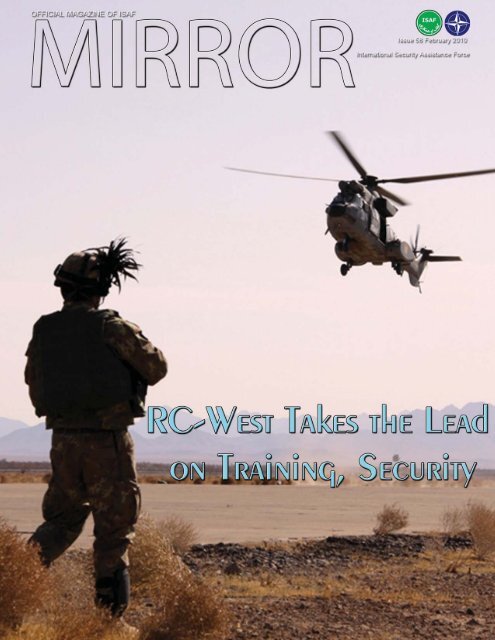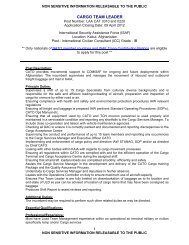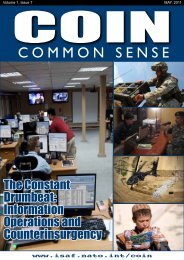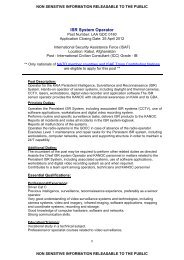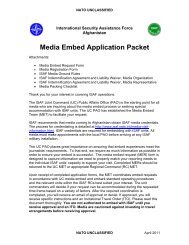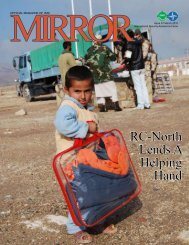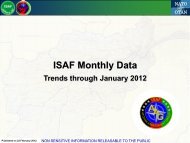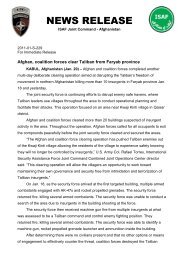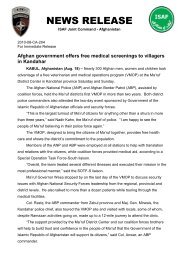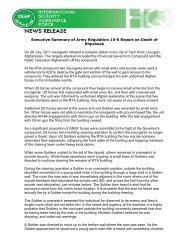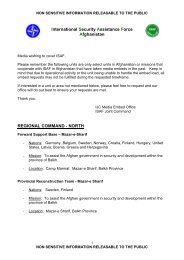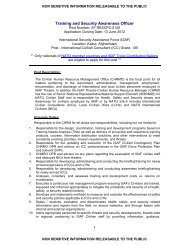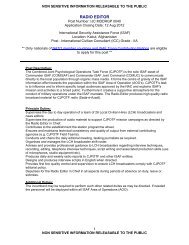Create successful ePaper yourself
Turn your PDF publications into a flip-book with our unique Google optimized e-Paper software.
province, in early January.Two days prior, in the same locationand by the same unit, a similarevent took place, bringing the twodaytotal to 136 of these devicesseized and destroyed.The Spanish-led PRT is showingtheir committment to the securityof Afghan population. Part ofthis effort is visible to locals asthey succeeded in removing thesedeadly items from the communityin just two days.Since Oct. 1, approximately150 Afghans have received cashrewards for reporting weaponscaches or providing tips leadingto the recovery of multiple weapons.On Jan. 11, during a presencepatrol in order to grant the freedomof movement in the area ofRC-West where Task Force Centeris operating, ISAF and ANSF’sJoint Operation in Zeerko Valleycaptured a great amount of ammunitionand weapons.This operation, which has beensupported by the civilian population,has resulted in a cache oftwo pressure plates, two anti-tankmines, 15 81-mm mortar grenades,five artillery bullets andtwo 107-mm rockets.Those materials, most of themused to make improvised explosivedevices to be used againstISAF or ANSF, were inside acargo van driven by a man who,after opening fire against ISAFand ANSF without causing anycasualties or damages, abandonedthe vehicle.The material was stored and thendestroyed by I.E.D.D. personnelbelonging to the Fifth EngineersRegiment “Sassari Brigade.”At the same time, American andItalian service members, with anAfghan National Army unit withaerial and helicopter support, carriedout a counter-insurgency missionin Zeerko Valley. As a result,several important insurgents havebeen captured as well as a greatamount of explosive material,arms, ammunition and drugs.Zeerko Valley is one of themost important areas for ISAFforces in RC-West becausethrough this area passes a greatpart of opium production that isused to pay for Taliban activities.Because of that, ANSF, with thesignificant support of ISAF, are tryingto get control of the area.Last November, nearly 400 Italianservice members belonging toFirst Bersaglieri Regiment, began tooperate in this area in order to havea better control of the territory.TrainingAfter four intensive studyweeks with the “Guardia di Finanza”mentors at Camp Arena, 13Afghan Border Police personnel,two of them women, completedthe 25th mentoring course givenPhoto provided by Regional Command West Public Information Officeby “Task Force Grifo” servicemembers.The students have acquiredbasic knowledge about Afghanlaws related to police missions ingeneral, borderline control and thefight against smuggling. Anothertheoretical part has been aroundtraffic control and command andcontrol tasks.The most intense moment in theceremony was when both womenreceived their diplomas - one ofthem straight from the RC-Wcommander’s hands, the secondone received her title from anItalian OF-1. The presentationshowed the ISAF commitment toimprove the consideration towardwomen in Afghanistan.Mentoring the ANSF hasalways been a priority for ISAF,which has a desired end-state ofAfghans taking control, even insecurity missions.In this context, TF Grifo membersare carrying their missionsout in Herat province, takingorders from Italian-led RC-West.WWW.ISAF.NATO.INT 4
Afghans, ISAF secure strategic pointDuring the last days of a joint operation to controlforward strategic positions in western Afghanistan,Afghan and International Security Assistance Forcesoldiers were the object of repeated attacks withsmall arms and anti-tank rockets coming from 60insurgents.The efficient reaction, due to the coordination of theforces on the ground, has allowed them to answer thefire coming from the insurgents. Aerial support as wellas mortar fire have granted the complete freedom ofmovement and the control over the whole area.The engagements, lasting more than 72 hours, tookplace in Bala Mourghab, the city which hosts a forwardoperating base for American (Task Force Fury)and Italian Soldiers that form Task Force North, basedon 151st Regiment, Sassari Brigade.The Afghan community of Mourghab district,whose Security Council members have been present atthe command post, actively supported the operation.The expected result of the operation is ending thethreat and providing complete security support towardthe civilian population.During a shura held the day of the operation, thevillage elders expressed their complete support toBy Regional Command West Public Information Offi cePhoto provided by Regional Command West Public Information OfficePhoto provided by Regional Command West Public Information OfficeAfghan, U.S. and Italian service members discuss anoperation prior to execution. The operation was to secureBala Mourghab, a stratgic point near the borderto Turkmenistan.the military operation. One of them expressed hisown gratitude.“Thank you my brothers,” stated the eldest personof the village. “You are here to bring development, assistanceand hope.”With the situation stabilized, ISAF forces are continuingwith reconstruction anddevelopment, helping with the humanitarianaid distribution, medicalassistance and other initiativesalready successfully carried outduring November and December.Bala Mourghab, located northeastof Herat, near the border toTurkmenistan, is in Baghdis province(one of four that form RC-West, under Italian Command) andis an area that was under insurgentcontrol. ANSF forces, with ISAFsupport, have recovered control ofthe area.Now, the control of the valley,a strategic point near the border,is important because through thisvalley passes the Ring Road, aroad around the country linking themain Afghan cities.WWW.ISAF.NATO.INT 6
ANP learns life-saving skillsMore than 40 Afghan NationalPolice officers are learning the skills requiredto save their friends’ lives on thebattlefield, if they are ever wounded.The knowledge comes in the formof self aid and buddy care, or SABC,training being conducted by U.S.forces who have been living, workingand mentoring with the Afghans sincearriving in Sar Howzah, Afghanistan,more than two months ago.“This training is very importantbecause we’re learning the moderntechniques of war and modernmedical techniques,” said AfghanNational Police 2nd Lt. HomayounNabard, Sar Howzah ANP districtcommander. “We hope we continueto learn from the international forcesand they continue to train us.”The training is conducted for up totwo hours, two to three times a weekand focuses on basic techniques. Oneof their primary instructors is a U.S.Army sergeant who has been a medicsince 1993.“They’re eager to learn how to saveeach other and their own lives. It’s likethey ask themselves, ‘do I want to learnthis, or do I want to die,’ so they reallyget into it,” said U.S. Army Sgt. JeremyGleason, a medic with 3rd Platoon,Blackfoot Company, 501st ParachuteInfantry Regiment.“The policemen that I have hereare all buddies, and on the battlefield,when we get attacked and sustainwounded, they don’t want to lose theirfriends,” Nabard said.The training conducted Dec. 24concentrated on the application oftourniquets and various carryingtechniques and included more thanstanding around a whiteboard. Thepolicemen were given time after theinstruction to practice applying theirBy U.S. Air Force Tech. Sgt. Nathan GallahanISAF Joint Command Public AffairsPhoto by U.S. Air Force Tech. Sgt. Nathan GallahanOne Afghan National Policeman practices applying a tourniquet on hisfriend after receiving basic self aid buddy care training from the U.S. Army.new skills on other trainees, beforeheading out to train under fire.They began by practicing movementformations so they could movetactically to their objective, which wasat the top of a mountain. U.S. leadersmentored Nabard with various tips andlearning points along the way so that hecould teach his men some of the moreadvanced techniques. Once at the top ofthe mountain, soldiers opened fire intoa range with mortars, sniper rifles andheavy and light machine guns, to simulateactual combat, while the policemenhad to utilize SABC to care for others,who were simulating wounds.“The sounds of the weapons andthe explosions were designed to mimicreal battlefield conditions,” said U.S.Army 2nd Lt. Josh Taylor, 3rd Platoonleader, Blackfoot Company. “It’s anarchyand scary when you have all ofthat going on, and now these guys canact within those conditions. Anybodycan put a tourniquet on, but when youhave a Mark-48 going off next to you,it’s a different story.”Gleason explained the SABC lessonplan being taught follows the samelines as U.S. Army training, whichconcentrates on Massive Bleeding,Airway, Respiration, Circulation andHead, or MARCH, wounds. The Dec.24 lesson covered massive bleeding,to be followed by the rest of MARCHduring later lessons.“If you teach them all of the skills,one at a time, and then throw ittogether in the end, it all makes senseand you start to see all of the littlelight bulbs turn on,” he said.Those little light bulbs may be thelight at the end of the tunnel for theANP here, and for their ability to accomplishthe mission.“From the time that coalitionforces have come and cooperatedwith the ANP, my policemen havea new, smiling face,” Nabard said.“Now we are prepared, now we havegood, trained personnel ready for thenew society here.”WWW.ISAF.NATO.INT 8
By U.S. Air Force Staff Sgt. Logan TuttleISAF Joint Command Public AffairsAfghans from all over the countryin need of medical care cometo Camp Dogan in Kabul, Afghanistan,to be treated.Here, approximately 400 patientsare in the care of Afghan andInternational Security AssistanceForce doctors, practicing a varietyof health care specialties.Care includes emergencies,general surgery, pediatrics, dentistry,dermatology and infectious diseases,though the hospital director, TurkishCol. Ramazan Akyildiz, says mostcome in to be treated for vehicle accidents,burns and diseases.“My sister has some problemswith her teeth,” said AbdullahHabnawavi, an Afghan fromMazar-e-Sharif who took his sisterin for treatment. “They have a lotof experience with teeth here; theyprovide a lot of medicine.”Most Afghans only have a 30-minute wait to be seen, and after a10-minute exam, doctors are ableto provide advice, further care ormedicine. Rooms are available forpatients to stay in for up to a week,and an ambulance is readily availablefor emergencies.The clinic also works closelywith French doctors at North KabulInternational Airport military compoundmedical treatment facility totransport patients for further emergencycare.Ailments treated by the cliniccan be anything from a stomachache to life-threatening injuries.Sometimes doctors on staff arePhoto by U.S. Air Force Staff Sgt. Logan TuttleA Turkish dentist from the International Security Assistance Force cleansan Afghan woman’s teeth Jan. 7, at a clinic at Camp Dogan. Approximately400 Afghan locals come here regularly to receive medical treatmentfrom a team of Afghan and Turkish doctors.needed to provide emergency care.“I was working in the city sellingvegetables, and I wanted to crossthe road. On the way, a car crushedmy leg; the driver took me to thishospital,” said Mirzade, a 12-yearoldboy who had his leg reconstructedat the clinic.“The hospital has been runningfor more than five years,” saidAfghan Dr. Khalid Hadi, a generalpractitioner and ultrasound specialist.“A lot of Afghans come heredaily.“The Turkish people would liketo help the Afghan people, so theywork here,” Hadi said in regards tothe spirit of cooperation here, withAfghan and Turkish doctors workingtogether.In addition to the critical careprovided here, the clinic alsotranslates information and reportsabout health and diseases into Dariand Pashtu. It then sends the documentsto the Afghan Ministry ofHealth. Akyildiz says the hospitalhas gone through reconstructionto open more facilities for theAfghan people, and plans for evenmore are underway.“I am so glad the hospital is inour area,” said Mohammed Sabur,an 80-year-old local.13 ISAF MIRROR FEBRUARY <strong>2010</strong>
Dreams do come trueAfghan boy plays soccer again thanks to Afghan, Turkish doctorsBy Regional Command Capital Public Affairs Offi ceAs we started out the New Year withhigh hopes and wishes for the best, one12-year-old boy in Afghanistan didn’tget off to such a great start. On Jan.2, Mirzade, one of the brighter students at FamilyanHigh School, was out hauling a push-cart to contributeto his family’s income.As he grew tired and weak, he turned around andnoticed a city bus coming directly toward him. Unfortunately,Mirzade wasn’t quick enough to move out ofthe way in time. The bus struck him trapping his leftfoot under the tire.Mirzade, covered in blood, was rushed to the InternationalSecurity Assistance Force Regional CommandCapital’s Military Camp, Camp Dogan’s “KabulAtaturk Hospital” by the same bus that struck him.The diagnosis was that the boy’s foot had no bloodcirculation due to detached veins and arteries. IfMirzade was not taken into an operation immediatelyhis foot would be amputated.With all the possibilities at hand, the hospital, whichhas services for the Afghan community, took Mirzadeinto an emergency operation. Dr. Engin Ilker Cicekand his Turkish crew of assistants went through a vigoroussix-hour operation, which was a complete success.The veins and arteries in his foot were revived.The sight of the boy’s foot before and after the operationis a true amazement which is far more impactingthan this story.According to reports by Col. Ramazan Akyildiz, directorof the hospital, the condition of Mirzade’s footseems to be making progress every passing day andif this progress continues Mirzade’s hopes of playingsoccer will come true.It turned out to be a happy new year for Mirzadeafter all.RC-Capital Helping with HajjPhotos provided by Regional Command Capital Public Affairs OfficeMembers of Regional Command Capital took a minor role in this year’s Hajj. Turkish Civil-Military CooperationTeams set up camps with cleaning necessities and food for those travelers awaiting departurefrom the Kabul area. The Hajj, the largest pilgrimage in the world, is an annual convention of faith thatdemonstrates the concept of equality of mankind, the most profound message of Islam, which allows nosuperiority on the basis of race, gender or social status.WWW.ISAF.NATO.INT 14
RC-North leader addresses mediaBy Regional Command North Public Affairs Offi ceThe Regional Command CommanderNorth German Brig.Gen. Frank Leidenberger helda press session with journalistsfrom local and regional mediaJan. 12 at Camp Marmal.At the beginning of the presssession, Leidenberger informedall the present media representativesabout the current situationand achievements in RC-Northarea of operations, stressing thesecurity situation has improvedin northern Afghanistan.Talking about the developmentand security issues, Leidenbergerpointed out that civilianreconstruction, sustaineddevelopment, advanced governanceand a comprehensive andintegrated approach are essentialfactors for the success ofAfghanistan.He also said ISAF forces willsupport the Government of theIslamic Republic of Afghanistanand help build-up the AfghanNational Security Force inthe way to enable them to conductself-contained operationsin order to stabilize populationcentric environs, as a guaranteefor further economic progress.Concerning the development,the RC-North commander saidthe construction works on thenew runway at the Mazar-e-Sharif Airport are finished andwill be handed over to Afghanauthorities in near future, addingthat this will provide thepopulation of Balkh Provinceas well as the entire northernPhoto provided by Regional Command North Public Affairs OfficeDuring a press conference Jan. 12 in Mazar-e-Sharif, Afghanistan, GermanBrig. Gen. Frank Leidenberger, Regional Command North commander,addresses the current situation and achievements in the RC-North area of operations. The local and regional media asked questionsconcerning ISAF’s intent to hand over the security responsibility to theAfghan government.Afghanistan a massive pushforward in terms of global connection.During the press session,Leidenberger informed themedia representatives with thecurrent status concerning U.S.force flow, adding that roughly2,500 U.S. troops, divided ina tactical aviation task force,engineers and police trainers,will be deployed to northernAfghanistan under his command.Answering the journalists’questions, the RC-North commandersaid the improvementof Afghan National SecurityForce is crucial in ISAF’s basicstrategy to hand over thesecurity responsibility to theAfghan government, and referringto the ISAF intent, is tostrengthen and increase ANSFespecially in manpower, equipmentand training matters.At the end, Leidenberger saidthat already achieved goals, togetherwith Afghan friends andcounterparts, are marvels butthere is still the need to step upefforts and to increase quantityof ANSF, especially the AfghanNational Police troops.15 ISAF MIRROR FEBRUARY <strong>2010</strong>
Bridge marks culmination of long-term collaborationBy U.S. Air Force Master Sgt. Mary HinsonISAF Joint Command Public AffairsAfter more than three years ofcollaborated efforts between thepeople of Zabul province and ProvincialReconstruction Team Zabul,the first-ever bridge in this provinceover the Arghandab River was dedicatedDec. 26.According to U.S. Air Force Lt.Col. Andy Veres, PRT Zabul commander,the 115-yard bridge mightnot be a world-record, but the impactit has on the community is undeniable.“It is a symbolic and technologicalachievement,” said Veres, who isfrom Melbourne, Fla.U.S. Air Force Maj. Gen. StephenP. Mueller, Air Component CoordinationElement-Afghanistan director,commented on the achievementduring a press conference before theopening ceremony.“First and most important, to builda bridge you must have a solid foundation,”said Mueller. “Without thisfoundation of trust and teamwork, itis impossible to build this bridge.”Mueller praised “confidence andstrength to reach across the unknown,”of both the governor and thepeople of the province.The Governor of Zabul province,Alhaj Mohammad Ashraf Naseri,also spoke on the importance of thebridge and its meaning to the community,to which the crowd applaudedfollowing the address.According to Veres, about aquarter of the province’s people liveon the north side of the river withlittle or no access to the south sideor Highway 1, which runs betweenKabul and Kandahar, and is the lifelineof commerce for the area. Zabulprovince is heavily agrarian, but thePhoto by U.S. Air Force Master Sgt. Mary HinsonU.S. Air Force Senior Airman Michael A. White looks over the fi rst-everbridge in the Zabul province over the Arghandab River during a dedicationceremony Dec. 26.transportation routes to disburse theirproducts were not previously available.Aside from adding to the economyof the province, Veres said that thebridge will tie the province to thecenter of government and help keepfamily ties together. In the spring, headded, when the river rises, familiesthat are on opposite sides get cut offfrom each other. With this bridge,the families will still be able to stayin contact.The bridge cost approximately$750,000 and was constructed bylocal contractors, which proved to bea major hurdle in getting the projectcompleted in a remote area. “Thebiggest difficulty was finding a localcontractor who had the right skills fora major project,” said Veres. “One ofour principle goals is putting Afghansto work within their community.”Veres said that using an outside,foreign contractor would not havehelped Zabul province in the longrun. The PRT wanted the experienceand the revenue from the project togo directly back to the immediatecommunity, so they made it a pointto have local contractors completethe bridge.“I commend Capt. GregoryOrbino, the PRT lead engineer, andhis staff: not just military, but theircivilian counterparts in the U.S.Army Corps of Engineers,” saidVeres. “There was a lot of mentoring,coaching on their part.“After all the challenges, I canonly imagine how good they feel tosee it being complete.”“The bridge is a commitment toshow we are giving, not taking thingsaway,” said Mueller, addressing thecrowd of elders who came to see thebridge opening. “We want to leavethe capability here for the province.This is a long-term commitment offriendship to all of you.”WWW.ISAF.NATO.INT 16


